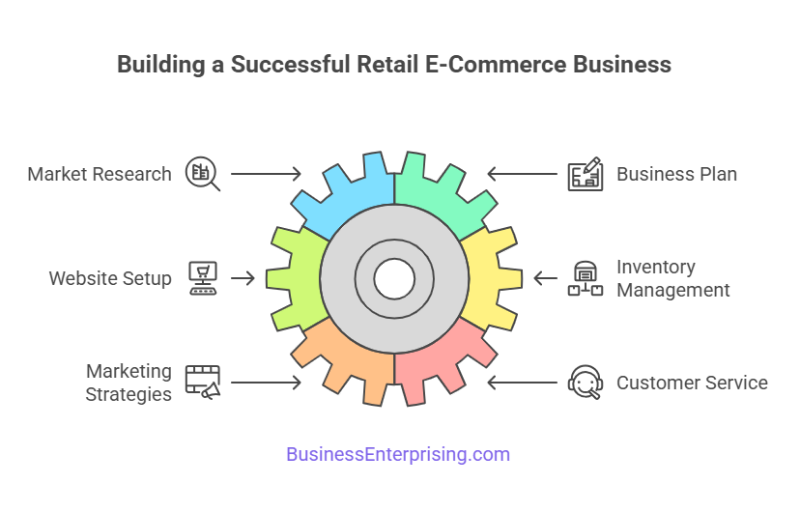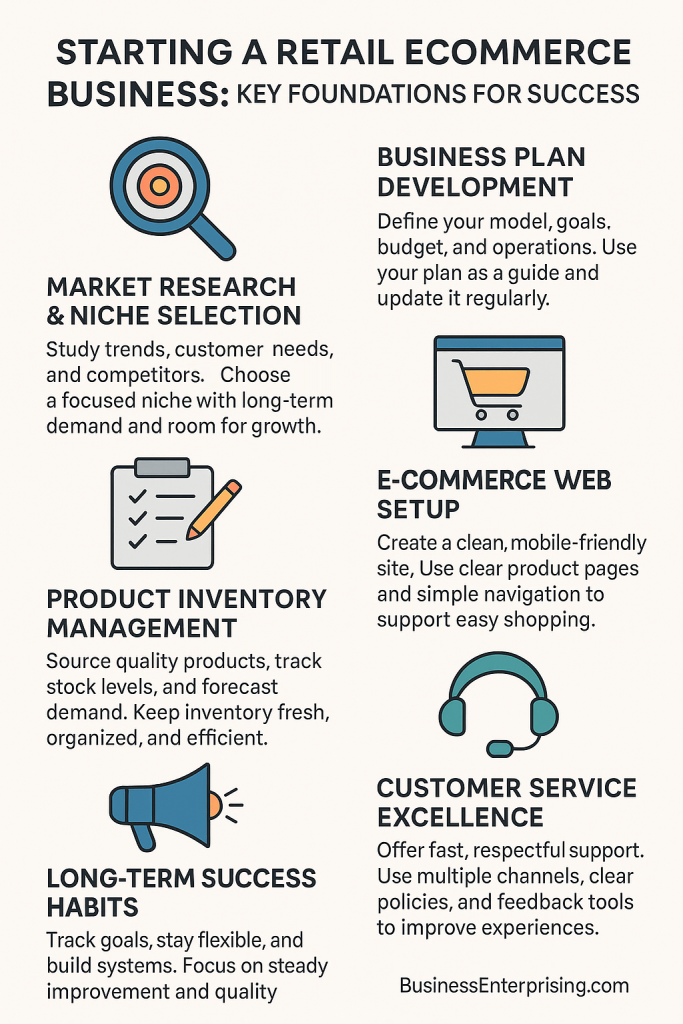 Starting a retail ecommerce business can seem simple at first. However, building something profitable takes planning, structure, and daily effort. You need more than a product and a website. Success comes from making smart choices across each part of your business. Therefore, your first step should always involve research. You must understand your market, define your niche, and know who your buyers are. Without this foundation, every other task becomes harder and less effective.
Starting a retail ecommerce business can seem simple at first. However, building something profitable takes planning, structure, and daily effort. You need more than a product and a website. Success comes from making smart choices across each part of your business. Therefore, your first step should always involve research. You must understand your market, define your niche, and know who your buyers are. Without this foundation, every other task becomes harder and less effective.
Additionally, a clear business plan helps you stay focused. It lays out your goals, budget, and how you’ll reach your customers. Planning ahead makes day-to-day decisions faster and more confident. However, execution matters just as much. You need a well-built website, consistent marketing, and reliable customer service. Each part plays a role in how people view your brand and whether they buy again.
Building an online store takes time. But if you stay organized, it becomes easier to grow. Focus on one task at a time and track your results. That way, you learn what works and where to improve. Additionally, keep your business flexible. Markets shift and buyer habits change quickly. Being willing to adjust can help you stay competitive and avoid waste. Your success will depend on small, repeated actions done well. Stay patient and focus on what matters. With the right mindset and consistent effort, you can build something real and profitable.
Market Research and Niche Selection
Choosing the right market is one of the first steps in building a profitable business. You need more than a good idea. Your product must solve a problem, meet a need, or satisfy a demand. That’s where research comes in.
Start by studying current trends and customer behavior. Look for buying patterns, gaps in the market, and emerging interests. Additionally, review what competitors offer and how they position themselves. This can help you find an angle that stands out. However, your research should also test long-term potential. A niche that sells well this month may not last the year. Therefore, aim for consistency over quick wins. You want steady demand and room to grow.
If you’re starting a retail ecommerce business, your niche matters even more. You need a focused audience that actively buys online. Broad categories can be harder to rank, market, and convert. Additionally, try to narrow your niche based on price range, style, or customer need. Smaller segments often respond better to targeted messaging. You’ll also face less direct competition. Therefore, validate your idea before investing time or money. You can run small ads or test products in low-cost ways. Use feedback to adjust and improve.
Once you choose your niche, stick with it. Jumping between markets can confuse your audience and hurt your brand. However, keep tracking what works and stay flexible. Solid research helps you avoid waste and build confidence in your decisions. When your niche is clear, the rest becomes easier to manage.
Developing a Business Plan
A business plan gives you direction and keeps your ideas grounded in real numbers and goals. Without it, you’re guessing. You need a written guide that outlines your market, products, and how you’ll operate day to day. Additionally, your plan should describe who you serve and why they buy. Include pricing, delivery options, and how you’ll stand out. This helps you stay focused and explain your concept to others. Investors or lenders often ask for a clear plan before offering support.
If you’re starting a retail ecommerce business, planning becomes even more important. You must account for product sourcing, logistics, and digital marketing. Your plan should also address inventory, shipping costs, and return policies. Therefore, include financial projections with estimated expenses and revenue. Break this down monthly for the first year. These numbers don’t have to be exact, but they should be realistic and well thought out. They guide your early decisions and show where adjustments may be needed.
However, a business plan isn’t something you write once and forget. Review it every few months. Make changes based on what you’ve learned or how the market shifts. Staying flexible keeps you in control. Additionally, use your plan to track performance and set new goals. It becomes a tool, not just a document. A good plan helps you stay organized and focused on what matters most.
Writing a business plan takes time, but it’s worth the effort. It helps you work smarter and reduces costly mistakes. You’ll thank yourself later for taking it seriously. Once you have identified a viable niche, the next step is to develop a comprehensive business plan. A well-crafted business plan serves as a roadmap, guiding your business decisions and helping you stay focused on your goals. Your business plan should include the following elements:
Executive Summary
The executive summary provides an overview of your business, including your mission statement, business objectives, as well as a brief description of your products or services.
Market Analysis
This section outlines your market research findings, including target audience demographics, market trends, and competitive analysis.
Business Model
Describe your business model, detailing how you plan to generate revenue. This section also includes your pricing strategy, sales channels, and revenue projections.
Marketing and Sales Strategy
One of the most important aspects of starting a retail ecommerce business is developing a solid marketing and sales strategies, including how you plan to attract and retain customers. This section should cover online marketing tactics, social media strategies, and customer relationship management.
Operational Plan
Detail your operational plan, including your supply chain management, inventory management, and logistics. This section should also cover any partnerships or collaborations with suppliers and distributors.
Financial Plan
Provide a detailed financial plan, including startup costs, projected income statements, cash flow statements, and balance sheets. This section should also include funding requirements and potential sources of financing.
Setting Up Your E-Commerce Website
Your website serves as the foundation of your online business. It needs to function well and look professional. If your site is confusing or slow, customers will leave before buying. You must get the basics right from the start.
If you’re starting a retail ecommerce business, your site should be easy to navigate. Clear categories, search features, and product filters help customers shop faster. Therefore, organize your layout around how people actually browse and buy. Additionally, product descriptions and images matter. Use clean photos and short, helpful descriptions. Highlight size, features, and shipping details. These small things can influence a buyer’s decision.
Your checkout process also needs attention. It should be fast and simple, with minimal steps. However, offer multiple payment methods and display trust signals. These elements build confidence and reduce cart abandonment. Therefore, choose a platform that gives you control over your design and settings. You don’t need to hire a developer, but the platform should be reliable and flexible. Test it often to catch any errors or issues before they affect your customers. Additionally, track site performance and make updates as needed. Mobile users make up a large share of traffic. Make sure your site works well on phones and tablets.
Starting strong online gives your business a better chance at long-term success. Your website doesn’t have to be fancy, but it does need to be functional and focused on your customer. Make it easy to shop, and you’ll give people a reason to come back.
With your business plan in place, the next step is to set up your e-commerce website. Your website is the foundation of your online retail business, and it must be user-friendly, visually appealing, and optimized for search engines. Here are the key steps to setting up your e-commerce website:
Choose a Domain Name and Hosting Provider
Firstly, select a domain name that is easy to remember, relevant to your business, and reflects your brand identity. Next, choose a reliable hosting provider that offers robust security, scalability, and fast loading times.
Select an E-Commerce Platform
There are several e-commerce platforms available, each with its own set of features and pricing plans. Popular platforms include Shopify, WooCommerce, BigCommerce, and Magento. Choose a platform that meets your business needs and budget.
E-Commerce Website for Your Startup
Designing your website involves creating a layout that is visually appealing and easy to navigate. Use high-quality images, clear product descriptions, and a consistent color scheme that aligns with your brand identity. Additionally, ensure that your website is mobile-responsive, as a significant portion of online shoppers use mobile devices. Consider using a good website designer.
Set Up Payment Gateways
Integrate secure payment gateways to facilitate smooth and secure transactions. Popular payment gateways include PayPal, Stripe, and Square. Offering multiple payment options enhances the customer experience and can increase conversion rates.
Implement SEO Best Practices
Search engine optimization (SEO) is critical for driving organic traffic to your website. Implement SEO best practices, such as using relevant keywords, optimizing meta tags, and creating high-quality content. Additionally, ensure that your website has a fast loading speed and a secure HTTPS connection.
Building Your Product Inventory
Managing your product inventory takes planning and attention to detail. You can’t sell what you don’t have on hand. You also don’t want to tie up cash in items that sit for months. Therefore, start small and build based on actual sales.
If you’re starting a retail ecommerce business, choose products that move steadily and offer good margins. Avoid guessing what people want. Instead, study trends, competitors, and past customer behavior. Additionally, test a few items before ordering large quantities.
Your suppliers play a big role in how you manage stock. Choose vendors with reliable delivery times and fair pricing. However, don’t depend on just one. Having backups can save time when problems come up. Additionally, track your stock levels closely. Use software or spreadsheets to log inventory and update it with every sale or return. This helps you avoid overstock and missed opportunities.
Forecasting can help, even with limited history. Review what’s selling, how fast, and in which seasons. Then adjust your orders based on real demand. Therefore, keep your product mix fresh but focused. Too many choices can overwhelm customers and complicate inventory control. However, packaging and storage also affect your operations. Make sure you have enough space and supplies to handle daily orders. Organize your items by category or sales volume for easier fulfillment.
When your inventory runs smoothly, your entire business benefits. Products arrive on time, customers stay happy, and you spend less time fixing mistakes. A smart inventory plan gives you the freedom to grow. Building a product inventory involves sourcing high-quality products that meet the needs of your target audience. Here are some key considerations when building your inventory:
Product Sourcing
There are several ways to source products for your e-commerce business, including manufacturing your own products, purchasing from wholesalers, or drop shipping. Each method has its own advantages and challenges, so choose the one that aligns with your business model and resources.
Inventory Management
Effective inventory management is crucial for maintaining stock levels, preventing stockouts, and reducing holding costs. Use inventory management software to track stock levels, manage orders, and automate reordering processes.
Product Listings
Create detailed product listings that include high-quality images, accurate descriptions, and relevant keywords. Highlight the features and benefits of each product, and provide clear pricing information. Additionally, use customer reviews and ratings to build trust and credibility.
Marketing Your E-Commerce Business
Marketing helps people find your business and understand what you offer. Without it, even great products can go unnoticed. You must build awareness and give people reasons to visit your website.
If you’re starting a retail ecommerce business, focus on the platforms your audience already uses. Social media, search engines, and email all play a role. However, don’t try to use everything at once. Start small and build as you go. Additionally, content helps you attract the right audience. Blog posts, product videos, and how-to guides show people what you know. These tools also improve search visibility and build trust over time.
Email marketing remains one of the most effective tools. Use it to share updates, promotions, and product launches. Therefore, collect emails through your website and offer value in every message you send. However, paid ads can help drive traffic quickly. Use a small budget to test what works. Focus on one platform at a time to keep results clear. Adjust your campaigns based on performance data, not guesswork.
Additionally, ask happy customers to leave reviews. Social proof influences buying decisions and helps new visitors feel confident. Display testimonials and ratings on your product pages and homepage.
Marketing takes consistency. You won’t see results overnight, but steady effort builds momentum. Therefore, create a simple calendar to plan posts, emails, and campaigns in advance. Track what performs best and do more of it.
With the right approach, marketing can support long-term growth. You just need to stay focused and make your message clear. Marketing is essential for attracting and retaining customers, and there are several strategies you can use to promote your e-commerce business:
Content Marketing
Content marketing involves creating valuable and relevant content to attract and engage your target audience. This can include blog posts, videos, infographics, and social media posts. By providing informative and entertaining content, you can build brand awareness and drive traffic to your website.
Social Media Marketing
Social media platforms are powerful tools for reaching a large audience and building a community around your brand. Use platforms like Facebook, Instagram, Twitter, and Pinterest to share content, run ads, and engage with your audience. Additionally, consider collaborating with influencers to expand your reach.
Email Marketing
Email marketing is an effective way to nurture leads and retain customers. Build an email list by offering incentives such as discounts, free trials, or exclusive content. Send regular newsletters, product updates, and personalized offers to keep your audience engaged.
Pay-Per-Click (PPC) Advertising
PPC advertising involves paying for ads that appear on search engines, social media platforms, and other websites. Platforms like Google Ads and Facebook Ads allow you to target specific audiences based on demographics, interests, and behaviors. PPC advertising can drive immediate traffic to your website and increase conversions.
Providing Excellent Customer Service
Customer service can shape how people view your business. A single poor experience may lead someone to never return. Therefore, clear communication and timely support matter from the beginning.
If you’re starting a retail ecommerce business, expect questions about orders, returns, and products. Your job is to respond quickly and clearly. Additionally, offer multiple ways for customers to reach you, such as email or chat. Not everyone wants to call or wait for a reply. However, speed alone isn’t enough. People want to feel heard and respected. Use polite, direct language and avoid canned responses. A thoughtful reply shows you care about their experience.
Therefore, create a system for tracking support requests. This keeps your team organized and prevents missed messages. It also helps you spot patterns in customer complaints or questions.
Additionally, set clear policies for returns, refunds, and shipping. Display them on your website where people can find them easily. This reduces confusion and builds trust before issues arise.
Ask for feedback after each interaction. Short surveys or rating tools help you learn what works and what needs fixing. However, be ready to act on what you hear. Improvements matter more than apologies.
Train your team to stay calm under pressure. Not every customer will be polite or patient. A steady, professional tone helps defuse tough situations and protects your brand.
Excellent service builds loyalty and drives referrals. People remember how you made them feel. Keep it simple, helpful, and consistent. Your reputation will grow one good experience at a time.
Providing excellent customer service is essential for building customer loyalty and encouraging repeat business. Here are some tips for delivering top-notch customer service:
Offer Multiple Contact Channels
Provide multiple contact channels, such as phone, email, live chat, and social media, to make it easy for customers to reach you. Respond promptly to inquiries and resolve issues efficiently.
Create a FAQ Section
A comprehensive FAQ section can address common customer questions and concerns, reducing the need for direct inquiries. Include information on shipping, returns, payment methods, and product details.
Implement a Clear Return Policy
A clear and fair return policy can enhance customer trust and satisfaction. Make sure your return policy is easy to understand and accessible on your website.
Conclusion
Starting a retail ecommerce business takes more than listing products online. You need structure, strategy, and patience to build real results. Every step, from research to service, plays a role in your growth.
Additionally, your success depends on how well you plan and follow through. A clear business plan gives you direction and keeps goals realistic. However, you also need flexibility. Markets shift, and customer behavior changes. You should review your approach often and adjust where needed. Therefore, focus on the basics first. Build a simple, effective website. Keep your inventory manageable and well organized. These choices reduce stress and improve operations. When things run smoothly, your customers notice.
Marketing takes steady effort. You won’t see big results right away. However, regular content, ads, and email outreach add up over time. Stay consistent and track what works best for your audience. Additionally, your customer service shapes your reputation. People remember fast replies and fair treatment. Make every client interaction count. Positive word of mouth can bring in more business than any ad campaign.
You don’t need to do everything at once. Start with what you can manage, then scale as you grow. Set clear goals and measure progress each month. This keeps your decisions grounded in data, not guesswork. If you build on solid habits and realistic expectations, growth becomes more sustainable. Starting a retail ecommerce business takes effort, but it also creates freedom. When you stay focused on service and quality, your business has room to succeed.


